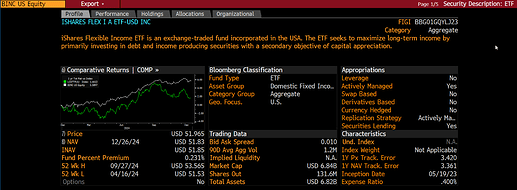Preamble
As the topic title says, this is a topic for discussing Fixed Income (FI) investing.
It is not a topic for discussing FI investing versus investing in other asset classes.
Feel free to discuss currency risk exposure, but please don’t make it the main topic.
Cash flow is money these people – like myself* – want to live off on a monthly basis and therefore want it to be stable income.
They do not want to be exposed to asset price fluctuations when they need sell because they need cash.
Nor do they want dividends that might be cut because of a bad year.
Thus, if you’re not interested in FI aka Bonds and/or feel equities are a better investment vehicle long term: I agree with you.
But please consider moving on, as this is not what I would like us to discuss here.
I’d like to discuss within the FI universe for people interested in fixed income what might be interesting.
And what we should perhaps avoid.
With that out of the way …
I recently came across BINC, an actively managed bond ETF by Blackrock, currently yielding above 6%, and aiming to yield 6% to 6.5% (in USD).
Video description here: https://youtu.be/PMzETiuLItA?si=u9CNuNo7FzC9ecVo&t=3205
Bloomberg profile here:
Things I found interesting:
- according to the (apparently) legendary bond (fund) manager Rick Rieder it’s relatively easy to outperform a bond index (as compared to outperforming an equity index)
- about USD 7 billion in AUM even though only launched in May 2023
- they’re aiming to create 6% to 6.5% yield (bond selection will target the yield range: the holdings will flow from that)
I just bought my first tranche and I’m considering moving at least my BNDX allocation to BINC. BNDX invests alongside the Bloomberg Global Aggregate Index* ex US but “only” yields a little over 4% with an at least similar if not higher risk than BINC.*** And, despite (or because of?) being passive, it trails the bond index performance …
* Goofy is going to live off his portfolio starting next year. This scary outlook has turned Goofy into a temporary Chicken Little, wanting to generate income above all else. Goofy will likely return to equity investing (including stockpicking) once he has live experience and can stomach his approach working under the conditions his portfolio weathers next year.
** Think global universe and “Gold Standard” for bond investors.
*** As I am writing this up, I am seriously wondering why BNDX doesn’t yield significantly more than US treasuries. Pretty sure if US treasuries default, BNDX will be a dead fish belly up in a stinking sea of global bond investments … maybe other forum members have better informed views on this.
